Discover 7 hidden attractions, cool sights, and unusual things to do in Sanford (United States). Don't miss out on these must-see attractions: Temple Theatre, Downtown Sanford, and Rosemount–McIver Park Historic District. Also, be sure to include Seaboard Milling Company in your itinerary.
Below, you can find the list of the most amazing places you should visit in Sanford (North Carolina).
Table of Contents
Temple Theatre
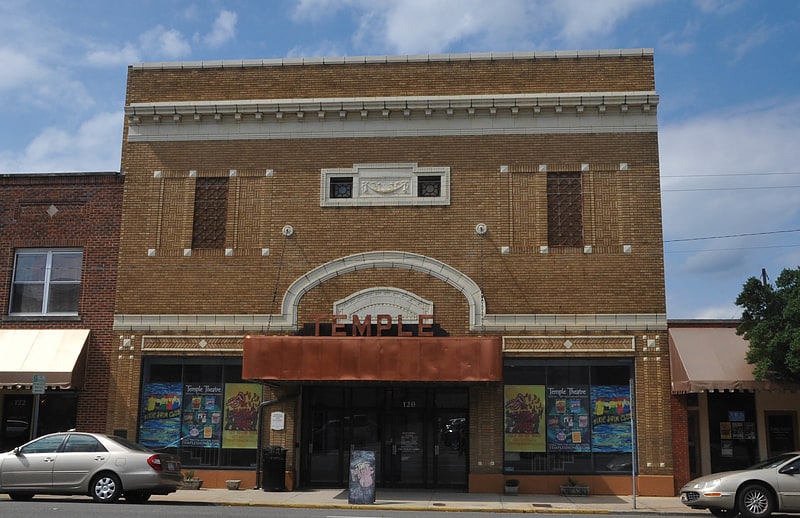
Theatre in Sanford, North Carolina. The Temple Theatre is an historic performance center in Sanford, Lee County, North Carolina. The Temple Theatre was built in 1925 by Robert Ingram, Sr. at a time when Sanford had a population of only 3,500. The name "Temple" comes from being located next door to what was once Sanford's Masonic Lodge. The following quote ran in a 1925 issue of the Sanford Express, "In erecting this modern theater, he has spared no expense to make it an up-to-date playhouse." It is a 50 feet wide-by-92 feet deep, two-story, brick building decorated with cut stone details in a blend of Colonial Revival and Art Deco styles.
For several decades, the Temple served as Lee County, North Carolina's principal seat of entertainment. Located half a block from the railroad station, the Temple was a frequent for the shows and stars of Vaudeville. Years later, the Temple became a touring house for the road shows of the 1930s (including burlesque), and then a movie theater. During the 1960s, the Sanford Little Theatre and the Footlight Players used the Temple for their community productions. In 1965, the Temple Theatre closed.
The rebirth of the Temple Theatre began in 1981 when Mr. Robert Ingram, Jr. the son of the theatre's original owner, donated the building to the citizens of Lee County. Through the efforts of Sam Bass, the building was listed on the National Register of Historic Places in 1983 and received a large challenge grant from the North Carolina Legislature. It is located in the Downtown Sanford Historic District. Lee County citizens and businesses matched the grant, along with a significant grant from the Z. Smith Reynolds Foundation. The building was gutted and the vandalized shell of Temple Theatre was refurbished with the comfort of both the patron and performer in mind. In 1984, Temple reopened as a community theater under director Kathy DeNobriga. The first show at the newly renovated Temple was Chicago. Ticket prices for an individual show were $3 and $4. A season ticket of 4 shows was $12. All shows were produced by the Footlight Players, and The Temple paid the bills and sold the tickets. The staff of the Temple at that time was Kathy DeNobriga, Director; Trip May, Tech Director; Sheila Brewer, Office Manager, Frank Nunally, Bookkeeper and Corrina Wicker, Box Office. In April 1986, Trip May took another position, and Tim Morrissey was hired as Technical Director. One of the first things he did was enlist the help of Sam Bass, and the two of them built the cover over the orchestra pit, which is removable.
In 1986 the first "Temple Theatre Day" was instituted. and held around April 1. It was a community and patron focused fundraiser. Patterned after The United Way's fund raising organization, the first one was chaired by local businessman Lamar Beach. Funds raised by this scheme were designated for the theatre's staff salaries, insurance and utilities throughout the year. It continued to be an annual event although the date was later changed to accommodate the theatre's fiscal year change to July 1 to be in line with the State's Art Council grant cycle.
In the summer of 1987 the Temple embarked on its first professional theatre venture, producing three shows in the summer of 1987 using casts and crews that were all paid. There were no union contracts at that time. In February 1988 DeNobriga moved to Atlanta where she took a position with Alternate Roots, and Morrissey was named Executive/Artistic Producing Director. In the summer of 1988 another professional show was done. In the Spring of 1990 Wally Eastland was hired as the technical director and Frank Nunally retired. Brewer took over the duties of the bookkeeper and office manager. Eastland left in 1993 and was replaced by Bill Freeman. Freeman left in 1996 and was replaced by Ron Smith. Smith left in 2000 and was replaced by Brad Sizemore.
In the summer of 1989 another professional show was produced using contracts with Actors' Equity. In the Spring of 1990 the Temple Board of Directors voted to accept a budget that included salaries for actors during the regular season. This was essentially the end of 'community' theatre at the Temple, and while various shows continued to use unpaid, local, actors and tech crew, many in those positions were paid- some union wages. In 1990, David Almond, who had been the musical director for the community theatre was replaced by Bert Fox. Fox stayed as MD until the summer of 1994, after which Musical Directors were contracted show by show. In the Fall of 1994 Serena Ebhardt became the General Manager. She remained in that position until 2000 when she left to pursue other theatre activities. Kathy Stallings replaced Ebhardt and she left in 2001. Wicker retired in 1996 and the box office was filled with various part-time help.
In the fall of 1995 the Temple sponsored a community theatre named "The Community Playhouse'. They produced 1 show a year each September from 1995-1998.
The roof on the theatre was completely replaced in the summer of 1998. In the Spring of 1996 the balcony was reconfigured, removing two rows of seats and converting the tech office into a reception room. The capacity of the theatre was reduced, and with the addition of computerized box office ticketing, the theatre seating could be adjusted to allow only 299 seats to be sold, fulfilling an agreement with Actors' Equity for a special contract.
The sound equipment was moved to the balcony in the rear. It was later found to be unsatisfactory, so a special booth was built out over the audience from the balcony. In the Fall of 1997, a temporary light truss was added to the down stage for the show 'The Invisible Man'. It was still there in the fall of 2001.
The marquee sign, the copper letters 'TEMPLE', were constructed by the metal workers at King Roofing in Sanford, in 2000. They used an old sign that had been there made of galvanized steel. Morrissey found the old sign while rummaging around in the underground part of the theater. The new copper sign was paid for as a donation by Dave and Kelly Kurz.
Morrissey left the Temple in Oct 2001, becoming the Executive/Artistic Director at The Highlands Playhouse in Highlands, NC and was replaced by Jerry Sipp. Staff at that time was Sipp, Sizemore, Brewer and part-time help in the box office.
The lobby's richly painted walls and wooden trim flank the original multi-colored floor of hexagonal tiles. Above hangs a crystal chandelier accented in gold, while twin staircases sweep up on either side of the lobby leading to the balcony where the restored tin ceiling can be best appreciated. Backstage, the actors enjoy comfortable dressing rooms, a kitchen, and a lounge area. That's not bad, considering the original structure had one bathroom for the performers and it was located in the basement. There is a full counterweight fly system backstage, an advanced communication network, and a computer-controlled lighting (last updated in 2010) and sound system (lasted updated in 2014), making the theatre practical and workable. Originally, the Temple seated 500. During the 80's renovation process, seating was reduced to 334, making it quite an intimate venue. The Temple also has an orchestra pit, which is utilized by musicians, but can be covered to create a larger stage. Because it was designed for vaudeville, the acoustics are superb - highlighted by an ornate painted tin ceiling, and audience members have a good view of the stage from every seat. In the spring of 2012, the Temple unveiled a brand new concession and restroom area.
The Temple is a cultural center and the top year-round attraction in Lee County. The North Carolina Shakespeare Festival, the Red Clay Ramblers, The Kingston Trio, the Glenn Miller Band, Count Basie, Mark Wills, The Embers, and Nantucket (band) are among the artists who have performed at the Temple Theatre.
Today, The Temple Theatre Company produces seven Main Stage shows per season ranging from musicals to dramas, with each show running for three weeks. All the actors are paid professionals brought in from across the country. The Temple Theatre is also a Comedy Zone venue, and has hosted a number of high-profile stand up comics in recent years, including Jimmie Walker, Carlos Mencia, Jon Reep, James Gregory (comedian), and Pauly Shore. Special events at the Temple range from pop concerts to dance recitals.
The Temple attracts patrons from the Research Triangle, the Piedmont Triad, and the Sandhills areas on a regular basis. In all, around 40,000 people visit the Temple each year. All funds raised during the annual fund drive go to the maintenance and operation of the facility (utilities, insurance, equipment, security, etc.). Production expenses come from ticket sales, sponsorships, grants, and advertising. The Temple Theatre is a non-profit organization.
The full schedule of events at Temple Theatre can be viewed at http:www.templeshows.org.[1]
Address: 120 Carthage St, 27330-4203 Sanford
Downtown Sanford
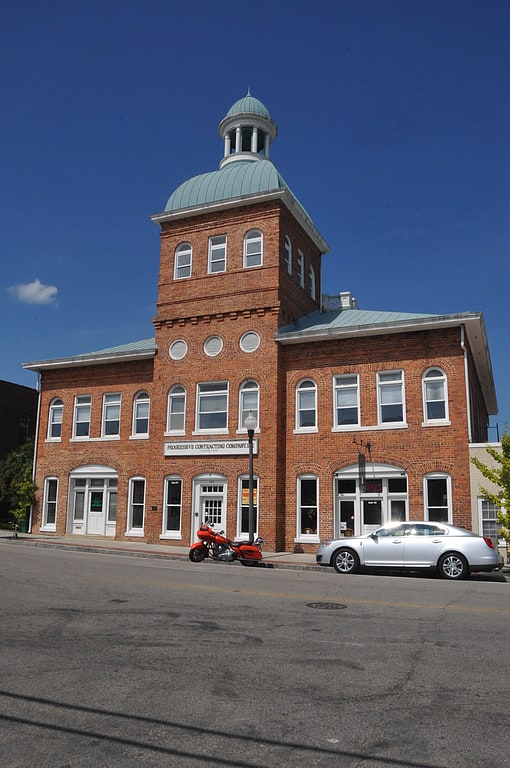
Downtown Sanford Historic District is a national historic district located at Sanford, Lee County, North Carolina. It encompasses 53 contributing buildings in the central business district of Sanford. The district includes notable examples of Colonial Revival, Tudor Revival and Art Deco style architecture, with buildings largely dated between about 1895 to 1930. Located in the district are the separately listed Railroad House and Temple Theatre. Other notable buildings include the Sanford Buggy Company, McCracken Building, Passenger Depot, City Hall, Coca-Cola Bottling Company, Masonic Lodge, Makepeace Building, Wilrick Hotel, Bowers Building, Cole Pontiac Building, Hubbards Shoe Store, Carolina Hotel, and former U. S. Post Office.
It was listed on the National Register of Historic Places in 1985, with a boundary change in 2021.[2]
Address: 118 S Moore St, 27330-4224 Sanford
Rosemount–McIver Park Historic District
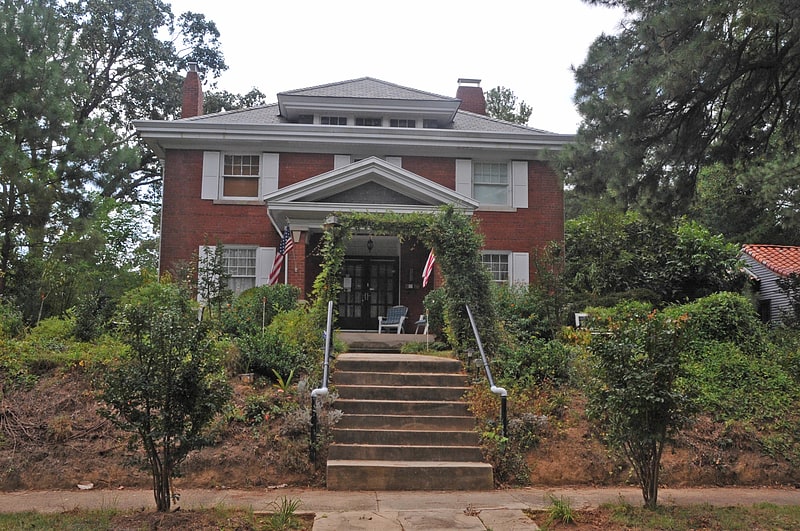
Rosemount–McIver Park Historic District is a national historic district located at Sanford, Lee County, North Carolina. It encompasses 169 contributing buildings, 1 contributing site, and 1 contributing structure in two residential neighborhoods of Sanford. The district includes notable examples of Colonial Revival, Tudor Revival and Queen Anne style architecture, with buildings largely dated between about 1900 to the early 1940s. The houses are characterized as one story, story-and-a-half, or two stories in height, ranging in scale from compact bungalows and cottages to manorial residences.
It was listed on the National Register of Historic Places in 1997.[3]
Seaboard Milling Company
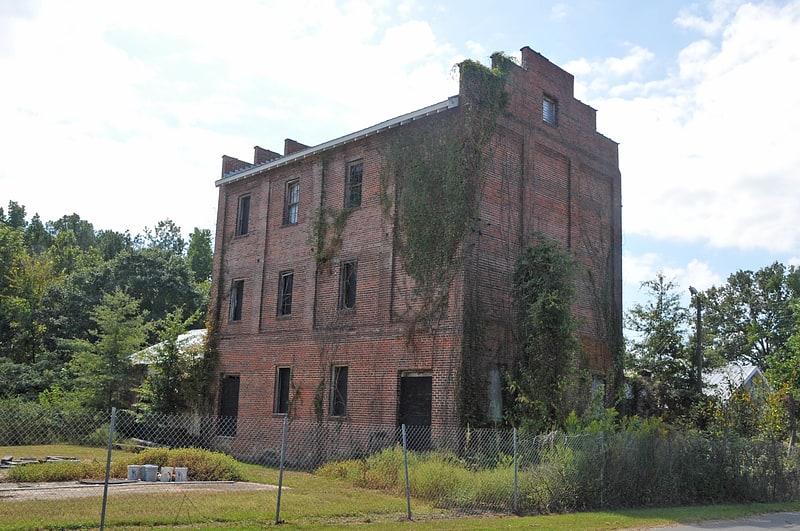
Seaboard Milling Company, also known as Seaboard Roller Mill and Broadway Roller Mills, is a historic roller mill located at Sanford, Lee County, North Carolina. It was built in 1915–1916, and is a three-story, brick building with a gable roof with stepped end parapets and traces of decorative exterior painting. It has a one-story metal-sided frame wing erected in two phases about 1920, and a one-story cinder-block office wing from the early 1950s.
It was listed on the National Register of Historic Places in 2002.[4]
Lee County Training School

Lee County Training School, also known as the W. B. Wicker School, is a historic school building located at Sanford, Lee County, North Carolina. It is a one-story brick building dating to 1927 with additions in 1934 and 1949. The building is characterized by large windows alternating with pilasters and was built by contactor A.L. “Link” Boykin, a leading member of Sanford’s black community. Construction funds were provided in part by the Rosenwald Fund, conceived in the 1910s by Southern black leader and educator Booker T. Washington. The Rosenwald schools were built across the south for black Americans in the early 20th century. It served as Sanford and Lee County's African American high school until it was decommissioned as a high school in 1969. Until the year 2019, classes for grade school were last held at the school in the late 1980s. It was listed on the National Register of Historic Places in 2000.
The W. B. Wicker School is one of the oldest educational institutions in Lee County with almost a century of history behind its doors. Under leadership of William Bartelle Wicker, this school allowed African American children a to get an education during the years of segregation, Jim Crow, desegregation and through the late 60s post-segregation era. It was during this time that the school was re-named from Lee County Training School to W.B. Wicker in recognition of William Bartelle Wicker's dedication and perseverance in providing quality education to the students of Lee County.
In 2001, Brick Capital Community Development Corporation (CDC), Lee County, the City of Sanford, and a local community Advisory Group worked together to restore the school. By November 2006, the revitalized school became the W. B. Wicker Business Campus and was home to Central Carolina Community College's Lifelong Learning Center, a four-star childcare center, and the Sanford business suites. From 2006 to 2018, Brick Capital CDC owned and managed the W. B. Wicker Business Campus.
In 2018, Lee County purchased the W. B. Wicker School from Brick Capital CDC in order return it to the Lee County Board of Education and transform it into an elementary STEAM (Science, Technology, Engineering, Arts, Math) school. The school revitalized three historic parts of the Wicker main campus- the main building, auditorium and gymnasium and expanded the school with a new building. With these additions, the school now holds a population of over 900 students.[5]
Hawkins Avenue Historic District
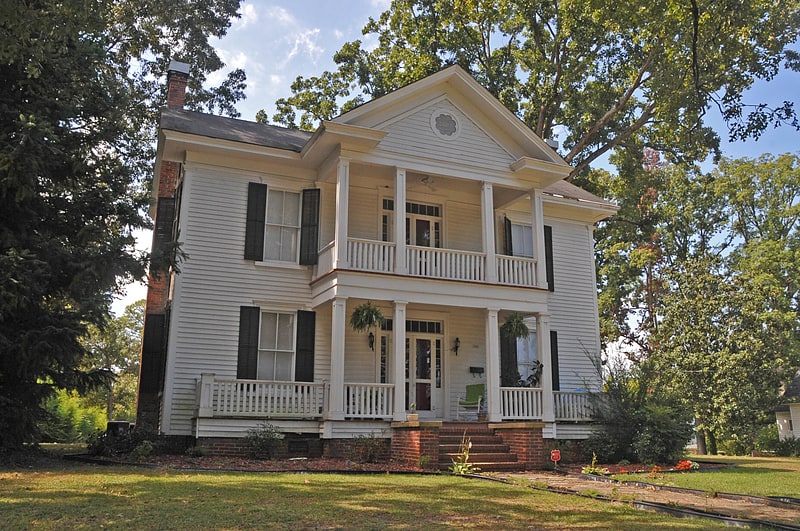
Hawkins Avenue Historic District is a national historic district located at Sanford, Lee County, North Carolina. It encompasses 200 contributing buildings and 4 contributing structures in a predominantly residential section of Sanford. The district includes notable examples of Colonial Revival and Queen Anne style architecture, with buildings largely dated between about 1900 to the 1930s. Located in the district is the separately listed Sanford High School, Former. Other notable buildings include the John McIver House, Duncan E. McIver House, Malcolm D. McNeill House, E.L. Gavin House, First Presbyterian Church of Sanford, First Baptist Church, the former Sanford Cotton Mill complex, and the Liles Bonded Cotton Warehouse.
It was listed on the National Register of Historic Places in 2000.[6]
East Sanford Historic District
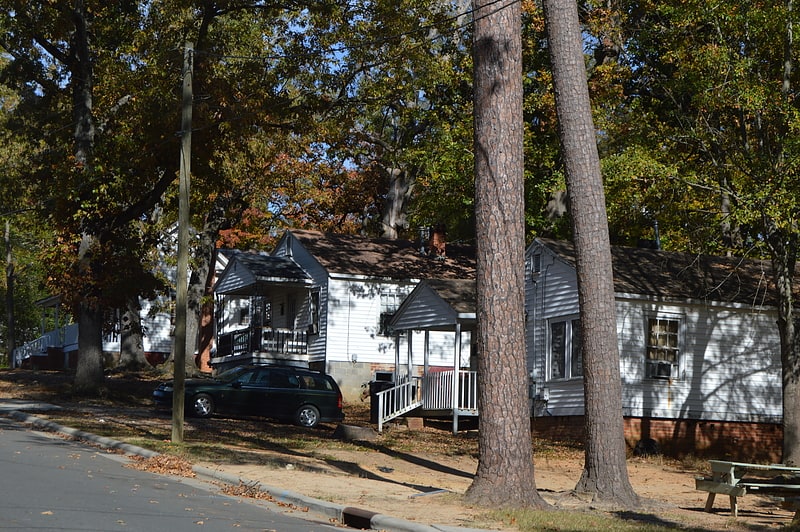
East Sanford Historic District is a national historic district located at Sanford, Lee County, North Carolina. It encompasses 135 contributing buildings and 1 contributing site in a predominantly residential section of Sanford. The district includes notable examples of Colonial Revival, Queen Anne, and Bungalow / American Craftsman style architecture, with buildings largely dated between 1894 and 1960. Notable buildings include the East Sanford Graded School, Sanford Congregational Christian Church, Deaton-Makepeace House, and Sanford Chapel.
It was listed on the National Register of Historic Places in 2010.[7]